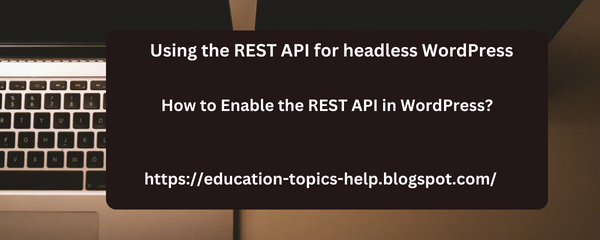Using the REST API for headless WordPress
Using the REST API for a headless WordPress setup is a powerful way to decouple the front-end and back-end of your website. With the REST API, you can retrieve and manipulate data from your WordPress site, allowing you to build dynamic and interactive web applications or websites using any technology stack you prefer. Here are the key steps to get started with the REST API in a headless WordPress setup:
How to Enable the REST API in WordPress?
Ensure that the REST API is enabled on your WordPress site. In most cases, it's already enabled by default. You can double-check by going to your WordPress admin panel, navigating to "Settings" > "Permalinks" and saving the settings. This action usually flushes the rewrite rules and ensures that the REST API is active.
Authentication:
To access the REST API securely, you'll need to set up authentication. There are several authentication methods available:
Basic Authentication: This method involves sending an Authorization header with your API requests. You can use a username and password for authentication. However, this method is less secure unless used over HTTPS.
OAuth: WordPress offers OAuth 1.0a and OAuth 2.0 authentication methods for more secure access. OAuth is recommended for production use.
JWT (JSON Web Tokens): You can also implement JWT-based authentication for headless WordPress. The WP REST API can be extended with plugins like "WP REST API - OAuth 1.0a Server" or "WP REST API - JWT Authentication" to support this.
Endpoints:
WordPress REST API endpoints allow you to interact with different types of data such as posts, pages, users, categories, tags, and custom post types. The API is organized around these endpoints. For example:
/wp-json/wp/v2/posts to retrieve a list of posts.
/wp-json/wp/v2/pages to retrieve a list of pages.
/wp-json/wp/v2/users to retrieve a list of users.
HTTP Requests:
Use HTTP requests to interact with the API endpoints. You can use tools like curl, Postman, or programming languages like JavaScript (using fetch or libraries like Axios) to make requests to these endpoints.
Example using JavaScript fetch API:
javascript code
fetch('https://your-wordpress-site.com/wp-json/wp/v2/posts')
.then(response => response.json())
.then(data => console.log(data))
.catch(error => console.error('Error:', error));
Data Manipulation:
You can use HTTP methods like GET, POST, PUT, PATCH, and DELETE to read, create, update, and delete data from your WordPress site via the API.
Custom Endpoints:
You can create custom endpoints by extending the WordPress REST API using plugins or custom code. This is useful for fetching specific data or performing custom actions.
Security:
Ensure your API is secure by implementing proper authentication and authorization mechanisms. This is crucial to prevent unauthorized access or data manipulation.
CORS (Cross-Origin Resource Sharing):
If your headless WordPress site is hosted on a different domain from your front-end application, you may need to configure CORS to allow cross-origin requests.
Testing and Documentation:
Thoroughly test your API requests and responses, and document your API endpoints for developers who will be working with your headless WordPress setup.
Performance Considerations:
Keep performance in mind, as API requests can introduce latency. Implement caching strategies where necessary.
By following these steps, you can effectively use the REST API in a headless WordPress setup to build dynamic and interactive web applications or websites.

Comments
Post a Comment